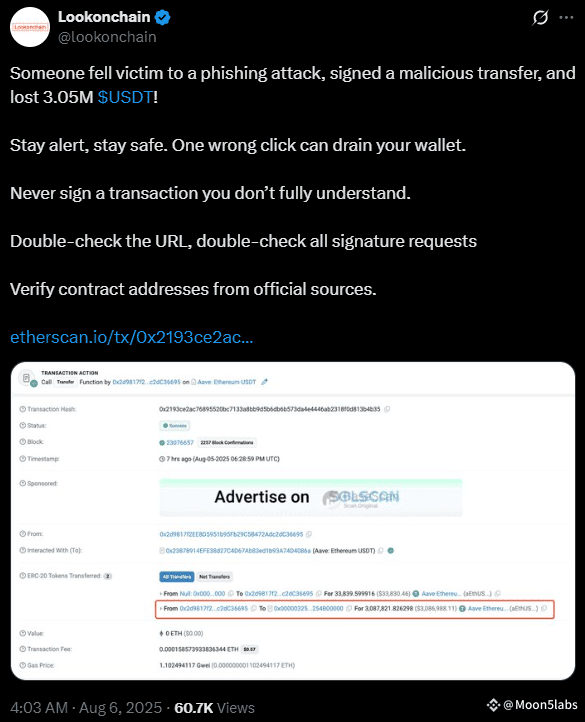Another alarming case of crypto phishing highlights how a single mistake can lead to massive losses. One investor lost over $3 million in Tether (USDT) after falling victim to a sophisticated scam that combined social engineering with malicious code.
According to analytics platform Lookonchain, the victim unknowingly approved a malicious transaction, not realizing it was part of a phishing attack. The firm urged all crypto users to avoid signing any transactions they do not fully understand — one wrong click could wipe out their entire wallet.

2025 Sees Surge in Phishing Attacks
Phishing scams in the crypto space have dramatically increased in 2025. Scammers often distribute fake links designed to steal sensitive information such as seed phrases, private keys, or wallet permissions.
Many platforms also truncate wallet addresses, hiding the middle section, making it difficult for users to verify their legitimacy — a tactic often exploited by attackers.
Other Victims: $900K USDC and a 458-Day Delay
Blockchain data revealed another attack where a scammer stole $908,551 in USDC, following an approval transaction the victim had signed back in April 2024. The attacker patiently waited nearly 15 months for the victim to deposit funds into the compromised address — and then struck.
Security firm Scam Sniffer highlighted this type of “sleeping approval” phishing as a growing threat, relying on attacker patience and highly targeted execution.

The $71 Million Phishing Case
In May 2024, one of the largest known phishing cases saw a user lose $71 million. The attacker eventually returned most of the funds, reportedly under pressure from blockchain investigators who traced a possible IP address located in Hong Kong.
Phishing: The Most Costly Threat in Crypto
A report by Certik confirmed that phishing was the most expensive attack vector in crypto during 2024. Across 296 incidents, over $1 billion in crypto assets were stolen. The real number is likely even higher due to unreported cases or harder-to-track scams like pig butchering.
Certik also published its Q2 2025 Web3 Security Report, revealing 144 incidents that caused $801 million in losses. In that quarter alone, 52 phishing attacks accounted for over $395 million. Ethereum suffered $65.4 million in losses across 70 attacks.
From January to June 2025, the crypto sector saw over $2.5 billion lost in 344 security incidents. A large portion of these included spoofing, with 132 cases causing $410 million in damages.
How to Protect Yourself
Experts strongly recommend using hardware wallets for storage, double-checking URLs, and never signing approvals blindly. Tools like Etherscan’s token approval checker can help revoke unnecessary token permissions — though users must pay gas fees to do so.
In 2023, a group of white hat hackers led by renowned dev Samczun formed a crypto hack response team, designed to help protocols recover from exploits. The group also introduced the Whitehat Safe Harbor Agreement to legally protect ethical hackers involved in rescue missions.
Binance Develops “Antidote” Against Phishing
Crypto exchange giant Binance has also launched its own anti-phishing tool — a real-time “antidote” that scans suspicious addresses and warns users before they mistakenly send funds to scammers.
#PhishingAlert , #Cryptoscam , #CryptoFraud , #CyberSecurity , #CryptoNews
Stay one step ahead – follow our profile and stay informed about everything important in the world of cryptocurrencies!
Notice:
,,The information and views presented in this article are intended solely for educational purposes and should not be taken as investment advice in any situation. The content of these pages should not be regarded as financial, investment, or any other form of advice. We caution that investing in cryptocurrencies can be risky and may lead to financial losses.“

